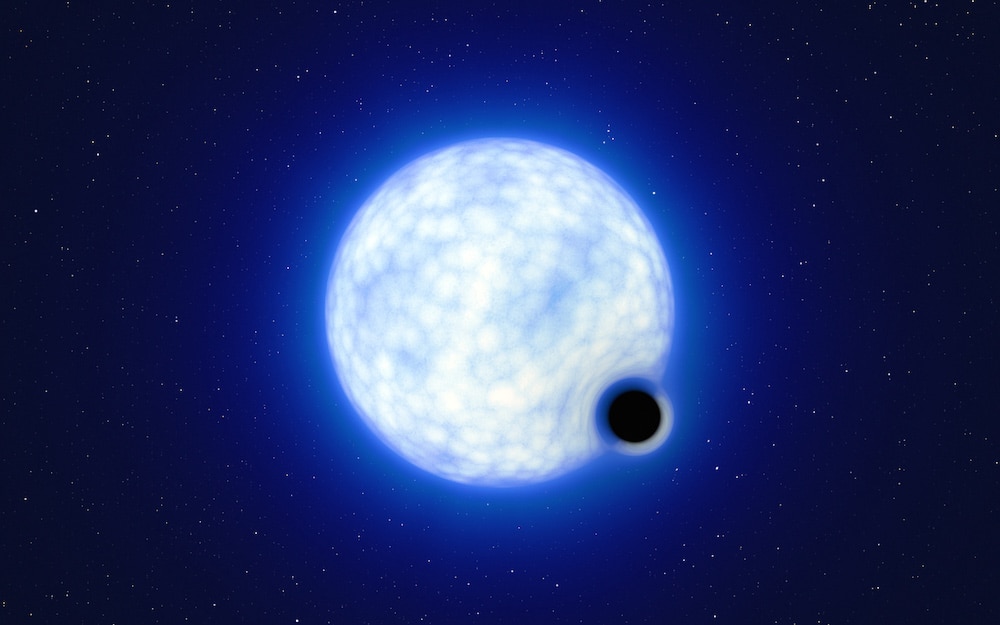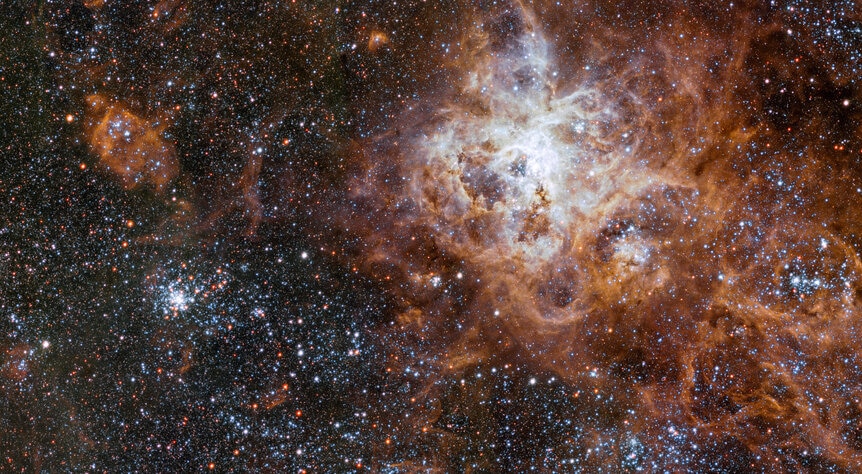Create a free profile to get unlimited access to exclusive videos, sweepstakes, and more!
The first dormant black hole likely found lurking in another galaxy
It orbits a monster star but isn't feeding off it.

Despite years of searching for stellar-mass black holes — ones up to a few dozen times the mass of the Sun that form when massive stars explodes — not that many have been found. And in all those cases they betray their presence by eating matter from a companion star, causing them to glow brightly in X-rays.
However, a very promising candidate stellar-mass black hole has been found in a neighboring galaxy. And, while it does appear to orbit a normal star, it’s not feeding, so it’s not giving off X-rays. Instead, it’s revealing itself through its powerful gravity, tossing around its binary companion.
Ironically, this black hole candidate was found by a team of astronomers known to destroy other astronomers’ claims of finding black holes!
The candidate is in a star system called VFTS 243. It’s in the Large Magellanic Cloud, a smallish galaxy that orbits our Milky Way, and one of the closest galaxies in the Universe to us. The normal star is “normal” in the sense that, like the Sun, it’s fusing hydrogen into helium in its core, but it’s actually extraordinary in that it’s very massive and luminous. It’s what we call an O-type star with 25 times the Sun’s mass and a brain-frying 160,000 times the Sun’s luminosity. It’s a beast.
It’s one of dozens of such stars being monitored in the Tarantula Nebula, itself a ridiculously huge gas cloud that is forming millions of stars — millions; the Orion Nebula is the nearest big starbirth factory to us and it’s only making some dozens of stars. The Tarantula is a monster.
Many very massive stars are forming in it, making it a great target to keep an eye on what stars like that do. Here’s where it gets interesting: Careful observations of VFTS 243 show that’s it’s in orbit around something [link to paper]. This can be seen by taking a spectrum, breaking its light up into individual colors, and examining the wavelengths. The spectrum undergoes a Doppler shift, with the wavelengths lengthening and shortening by a small amount, and this pattern is periodic, repeating every 10.4 days.
This is exactly what you expect if it’s in orbit around another object like a star. The size and shape of the orbit can be determined by the shift, as well as the mass of the other object.
And that’s the fun bit: The observations indicate the second object has a mass of about 9 times the Sun. If it were a star like the Sun that would make it very bright, and easy to spot. But no such star is seen. There’s no light coming from it at all.
The only thing known that can be that massive and utterly dark is a black hole.
The astronomers looked at deep X-ray observations and found no hint of them from VFTS 243, so if this is a black hole — and it does appear to be — it’s getting nothing from the O star. That’s actually a little odd, since massive stars have powerful winds of subatomic particles, like the solar wind on steroids, and if this matter were to get eaten by the black hole that would normally produce X-rays. However, as the astronomers point out, that matter has to pile up and form a disk around the black hole before falling in; the disk gets extremely hot and that’s what produces X-rays. Conditions in VFTS 243 don’t allow a disk to form, so no X-rays are expected.
The orbit of the star and black hole is fairly circular, which is again a little surprising. Many times, the supernova explosion that forms a black hole is off-center, blowing out more to one side than the other, and that creates a powerful kick that acts like a rocket thrust. That in turn would make the orbit more elliptical. Since the orbit is circular, that implies the explosion that formed the black hole was symmetrical, spherical.
That’s a good thing to know, since it would affect the evolution of the system over time, and understanding how systems like this behave is a big goal of astronomy. We detect gravitational waves from merging black holes pretty often, but how those systems form and how they eventually merge is still a mystery. Seeing them while they’re still young is a big help. I’ll note that O star is massive enough to explode someday, and it will very definitely form a black hole. Probably not for a million years or three, but again the more we understand these systems the better.
And I had to laugh when I read the author list for this paper. Kareem El-Badry is well-known to be someone who examines other astronomers’ claims of finding black holes like this one and showing they’re not correct — like this one, and this one — so much so that he put up an April Fool’s tweet about it a few years ago:
That might make you skeptical of this claim. However, in those other cases the big “normal” stars were actually ones that were dying, shedding their outer layers, and that can confuse the observations. In this case the star is a classic O star, with no apparent surprises, making the claim for VFTS 243 much more solid.
That makes it the most likely quiescent black hole ever seen in another galaxy. And I’ll note the team also found a similar case in our own galaxy with the star HD 130298, an O-type Milky Way star about 6,000 light-years from Earth. Pretty cool.
Finding black holes in this way is tough, because you have to monitor a lot of stars for a long time, and observe them fairly often because the orbits tend to be short. Looking for X-rays blaring is easier, but those systems are likely very rare compared to ones where the black hole is quietly orbiting another star. And there could be hundreds of millions of such systems in the Milky Way alone! So there are plenty left to find.




























